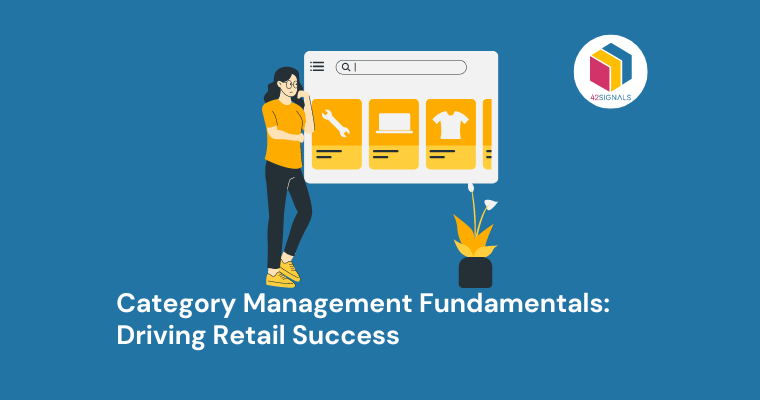Category management is a strategic approach used by retailers to optimize the performance of specific product categories within their stores. By treating each category as its own distinct business unit, retailers can gain a deeper understanding of customer needs, preferences, and behaviors related to that category. This information can then be used to inform key decision-making areas such as assortment planning, pricing, promotions, and merchandising.
Let’s explore the fundamentals of managing categories and how they can help retailers achieve their goals.
What is Category Management?

Image Source: Unstop
At its core, category management is a strategic approach to managing product categories within a retail environment. The primary objective of this function is to create value for customers by providing them with relevant products at competitive prices while maximizing profits for the retailer.
To do this well, category managers must have a deep understanding of their customers’ needs, preferences, and behaviors. They must also stay abreast of market trends, competitor activities, and industry best practices.

Image Source: Zycus
The Four Key Elements of Category Management
There are four key elements of managing a category that retailers need to master to succeed:
1. Assortment Planning
This involves selecting the right mix of products to offer in each category based on customer demand, sales history, and market trends. Effective assortment planning requires careful consideration of factors such as brand, price point, package size, and channel availability. By offering a carefully curated selection of products, retailers can differentiate themselves from competitors and provide unique value to their customers.
2. Pricing Strategy
Price is one of the most critical factors influencing consumer purchasing decisions. Setting the right price for each product in a category requires a delicate balance between maintaining profitability and remaining competitive. Category managers must consider factors such as cost, competition, and perceived value when setting prices. They may use various pricing strategies, including everyday low pricing (EDLP), high-low pricing, or promotional pricing, depending on the category and target audience.
3. Promotion Strategy
Promotions are another crucial factor in driving sales and building customer loyalty. Category managers must develop smart promotional strategies that align with their overall marketing objectives and budget constraints. These strategies may include discounts, coupons, rebates, or special offers. By analyzing historical sales data, category managers can identify patterns in consumer behavior and optimize their promotional efforts accordingly.
4. Merchandising Strategy
Finally, category managers must devise clear merchandising strategies that showcase their products attractively and encourage impulse purchases. This includes everything from store layout and signage to product placement and display design. A well-executed merchandising strategy can significantly impact sales performance, so it’s essential to invest time and resources into getting it right.

Image Source: Aavenir
Benefits of Implementing a Category Management Program
Implementing a robust category management program can bring numerous benefits to retailers, including:
1. Improved Customer Satisfaction
By focusing on meeting customers’ needs and preferences, effective management of products within a category helps improve overall satisfaction levels. Happy customers are more likely to return to your store and recommend it to others, leading to increased sales and revenue over time.
For example, a grocery store might expand its gluten-free options in response to growing demand from health-conscious consumers. A clothing retailer could send targeted emails featuring items similar to those previously purchased by a particular customer.
2. Increased Sales and Profitability
With better assortment planning, pricing, promotion, and merchandising strategies, management of the category can lead to significant increases in both sales and profitability. By optimizing these elements, retailers can capture more share of wallets from existing customers and attract new ones.
For instance, if a sporting goods store notices that certain types of fishing gear sell poorly compared to other outdoor equipment, they might choose to allocate more space to higher-demand items.
An electronics retailer might implement tiered pricing for televisions, offering several models at different price points to appeal to a broader range of customers.
A supermarket might run a “buy two get one free” sale on snack foods during football season, encouraging fans to stock up before game day.
3. Enhanced Competitive Advantage
Another benefit to managing a category well is how it enables retailers to differentiate themselves from competitors by offering unique product selections, pricing strategies, and shopping experiences. This can be particularly important in highly saturated markets where standing out from the crowd is challenging.
A home decor store might carry handmade items sourced from local artisans, creating a distinctive aesthetic that appeals to niche audiences.
4. Better Data Insights
Effective management of categories relies heavily on data analytics to inform decision-making processes. By investing in advanced analytics tools and techniques, retailers can gain valuable insights into customer behavior, market trends, and competitor activities. These insights can then be used to refine strategies further and drive continuous improvement.
For instance, a toy store might discover through predictive modeling that certain action figures sell better after movie releases, allowing them to plan inventory accordingly.
Consider a bookstore that uses RFID tags to monitor which titles are flying off shelves versus gathering dust, and adjusting orders as needed to maintain optimal stocking levels.
Conclusion
Overall, implementing a robust product management program provides retailers with a framework for making data-driven decisions that ultimately benefit both their bottom line and their customers.
However, it isn’t without challenges. It demands considerable investments in technology, expertise, and time. Yet, given the transformative power of adopting this function, the costs pale in comparison to the potential benefits.
As such, retailers should view managing a category as a foundational element of their overall strategy and commit wholeheartedly to its implementation and optimization.
42Signals helps brands with their category management and optimization techniques by providing them with the tools and data required to succeed.
From product-level insights to category performance data, this knowledge helps businesses improve their performance by focusing on the right strategies across marketplaces.
To read more such informative articles, visit our blog or insights page.







